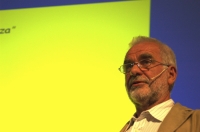 |
 |
|||||||||||||
|
|||||||||||||
|
|||||||||||||
|
The calorimeters for the ILC detectors have to show excellent performance if researchers want to fully exploit the physics potential of the ILC. Many processes that are unique for the physics programme of the ILC are characterised by multiple-jet production that can be reconstructed by new calorimetry techniques to very high energies with unprecedented precision. The goal is to improve the jet energy resolution already achieved by a factor of two to fulfil the physics requirements the best possible way. Hence we need to develop these novel technologies and show that they work by ‘proof of principle’. There already is a substantial R&D effort for calorimeters. Since the schedule for the ILC machine is taking shape it is essential now to enhance the R&D to ensure that ILC detectors of the necessary performance are ready in time for the machine start. During the LCWS and ILC 2007 workshops in Hamburg the Detector R&D Panel organised a global review on calorimetry. The Panel formed a dedicated committee of ten calorimetry experts from outside the ILC community and representatives from the major regions- Americas, Asia and Europe- to critically examine the ongoing R&D activities and to give guidance to the collaborations to sharpen their R&D goals. The committee members are listed in the R&D review talk. We invited all collaborations and groups working on the field of calorimetry - six in total - to summarise their R&D status, goals and plans in a written report available for the committee members two weeks in advance. The first one-and-a-half days of the review were devoted to presentations of the research results in open sessions, held in the large FEL lecture hall at DESY. Quite obviously, interest of the community was strong: there were so many people in the lecture hall that it was impossible to find a free chair. After the open sessions the committee invited each research group to a closed session allowing the committee members to discuss the research goals, technological priorities and the plans for the future in more detail. Finally, the committee drafted preliminary conclusions, communicated to the research groups in a closeout session on Monday. All collaborations prepared excellent reviews and presentations on their current research and future plans. The committee members were impressed by the broad effort and high quality of the ongoing R&D. We had an open and very constructive atmosphere both in the open and closed sessions. To make a personal comment, which is of course not a committee statement: After all the pleasure to chair this committee, I am sure that the review will help the community to better focus the R&D on the critical questions to be answered in the timescale of the ILC construction plan. Also I got the impression from the discussions at and around the review that the people in the collaborations understood that a higher level of communicaton and common effort between the collaborations is necessary to reach this goal. The conclusion on the review will be prepared in a written form and published after endorsement by the WWS. The next review on vertex detector R&D will take place at Fermilab in October 2007. -- Wolfgang Lohmann, DESY Zeuthen (Chair of the Calorimetry Review Panel) The R&D Panel would like to thank SLAC, DESY and FALC for their support, without which these reviews would be impossible. SLAC and DESY support our administrative team and FALC pay the expenses of our consultants from outside the ILC community, who provide unbiased, objective and expert advice. |
|||||||||||||
| © International Linear Collider |

